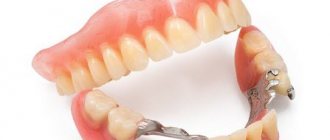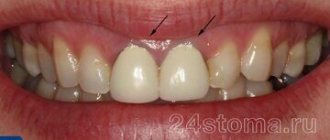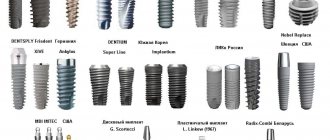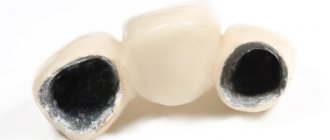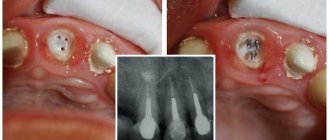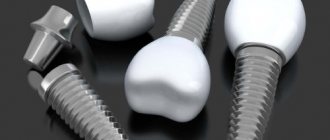Implantation of upper chewing teeth
In the upper jaw, the maxillary sinuses are located close to the roots of the molars and premolars, therefore, when implanting the upper chewing teeth located in this section, osteoplastic surgery is required in 80 - 90% of cases. The procedure of lifting the lower part of the sinus (maxillary sinus) and filling the space with biocompatible bone material is called a sinus lift. On the one hand, this is a completely simple procedure, but on the other hand, it requires certain knowledge and skill from the doctor. Therefore, it should only be done by trusted specialists.
Make an appointment
right now!
Bely Dmitry Valentinovich
Surgeon, Therapist, Implantologist
Implantation of lower chewing teeth
From a process point of view, implantation of chewing teeth in the lower jaw is the same as in the upper jaw. The fundamental difference is only in the timing of implant healing. When implanting lower chewing teeth, osseointegration occurs much faster than with implants in the upper jaw. It takes only about three months for complete engraftment. By the way, if osteoplastic surgery for implanting upper chewing teeth is called “sinus lifting,” then in the case of lower teeth it falls under the general concept of bone grafting.
What kind of implants are placed on chewing teeth?
If you think that dentists use the same implants to replace all types of teeth, you are wrong. Each clinical case uses its own treatment protocol and implant system, which should provide optimal results in terms of functionality and aesthetics. So, what kind of implants are placed on chewing teeth? To restore teeth in the lateral part of the jaw, implants that are too thin and short are not used. Depending on the anatomical features of the jaw structure and the width of the interdental spaces, the doctor selects their optimal size. As for the technique, classic two-stage implantation is usually used to restore chewing teeth (when an artificial root, after installation, is sutured into the gum and undergoes the process of osseointegration for 3 to 6 months). This is necessary for the implant to fuse with the bone tissue as efficiently as possible and subsequently withstand the chewing load.
During the engraftment stage, the patient is usually fitted with a temporary prosthesis, after which a permanent structure is installed. Almost all modern manufacturers have a line of implants for restoring molars and premolars. Both top-end and budget systems perform essentially the same function, but more expensive brands provide greater opportunities for prosthetics, and also allow you to obtain equally high functional and aesthetic results. In any case, your attending physician should tell you which implant is best placed on the chewing teeth in a particular case.
Important!
The human jaw creates a load of 400 kilograms, so the artificial root must have a large margin of strength.
Is bone augmentation necessary?
Osteoplasty is necessary for single restorations. The classic implantation method is used, which implies a satisfactory condition of bone and soft tissues (sufficient density, volume, absence of inflammation). In case of severe atrophy, before installing implants, bone augmentation is carried out by transplanting bone blocks or directed bone regeneration. This extends the treatment period by 6 months (until the material engrafts). But in most cases, osteoplasty is possible simultaneously with the installation of implants.
With full jaw immediate loading protocols, 90% of cases do not require augmentation. Protocols are designed for mild to moderate atrophy.
Bridge or implant on a chewing tooth: which design is better?
If several chewing teeth are missing in a row, a dilemma often arises: to place a bridge or an implant on the chewing tooth. Of course, the best option would be to place an implant on the chewing tooth, and then install an abutment and crown, but this is not always possible to do due to the high cost of the procedure and the lack of the required volume of bone tissue. In such cases, the patient is asked to install a bridge supported by his own teeth. The main disadvantages of such prosthetics are depulpation and grinding of supporting teeth, as well as increased load on them, which over time leads to their destruction.
Lower jaw implantation
The lower jaw is denser in structure than the upper jaw, so in most cases, 2 to 6 implants are enough to restore all teeth. The integration period for implants in the lower jaw is 3 months.
Removable prosthetics on implants in the lower jaw are carried out on 2-4 implants. The most common option is to install 4 implants with spherical attachments (or locators). The advantages of this method are good fixation of the prosthesis, easy oral hygiene, simplicity of design, and, as a result, its low cost. A removable prosthesis on 2 implants with attachments is used in cases where there is not enough bone tissue to install 4; the fixation of the prosthesis in this case is worse. The disadvantages of this treatment method are that the prosthesis distributes the load not only on the implants, but also on the gums. Under the pressure of the prosthesis, the gums atrophy, so it is necessary to reline the prosthesis on average once a year. The fastening on the attachments also weakens; it is necessary to periodically replace the retention matrices. The service life of the prosthesis itself is about 5 years.
Removable denture on 4 implants with spherical attachments on the lower jaw
The second option for a removable prosthesis on the lower jaw is prosthetics of the lower jaw on a beam on 4 implants. In this case, the load is distributed mainly on the implants and much less on the gums. The fixation of the prosthesis is very tight, the prosthesis feels almost like your own teeth. The prosthesis itself is made of plastic. It completely restores aesthetics and chewing function. The fact that the denture is removable simplifies oral hygiene. A plastic prosthesis is not as rigid as a metal-ceramic or zirconium one, so it is easier for people who have problems with the temporomandibular joint to get used to it. The disadvantage of this treatment method is that a properly manufactured beam prosthesis is comparable in cost to a fixed structure.
One of the main conditions for the long-term functioning of such a prosthesis is that the beam connecting the implants must be very accurately connected to them. For this, multi-unit abutments are used, which ensure precise connection of the implant with the beam; the beam itself must be made on a milling machine. Unfortunately, patients are often offered a bar prosthesis made without multi-unit abutments, or made by casting rather than milling. In this case, the beam will be fixed to the implants with tension, which will lead to a negative result, possibly even to the loss of the implants due to their overload.
Removable denture on a beam fixation on the lower jaw
Fixed prosthetics of the lower jaw are performed on 6 implants with classical implantation. It is also possible to restore teeth on 4 implants using the all-on-4 method, in which case 2 of the 4 implants are placed at an angle of up to 45 degrees. The technique has its pros and cons. All-on-4 will be written about later in this article.
Fixed prosthetics completely imitate your own teeth and are the easiest to tolerate psychologically. During the period of implant integration, the patient uses a temporary removable prosthesis, or dental implantation is carried out with a simultaneous load using a fixed plastic prosthesis. The service life of a plastic prosthesis is 1 year. It can be replaced with metal-ceramic or zirconium after the implants have completely healed. On the lower jaw after 3 months. The implants themselves are not affected.
In the case when a permanent prosthesis is made with screw fixation, we are talking about conditionally removable prosthetics on implants. Conditionally removable means that the prosthesis can only be removed by a dentist. The patient cannot remove it on his own; it feels and functions like his own teeth.
The advantages of screw fixation are that the prosthesis can be removed if necessary. Unlike cemented dentures, which cannot be removed without sawing them. However, the complexity of the design, and as a consequence the cost, is increasing.
Fixed denture on the upper jaw on 6 implants, on the lower jaw on 6 implants
Implants for chewing teeth - patient reviews
Patient reviews of the procedure for implanting chewing teeth are almost always positive, since today this technique allows you to be almost 100% confident in a good final result. Negative impressions are usually associated with the unprofessionalism of the doctor and an incorrectly performed implantation procedure. As for reviews of implants for chewing teeth from specific manufacturers, the leading brands include Nobel Biocare, Straumann and Astra Tech.
In any case, classical dental implantation can be performed only in the absence of serious contraindications, which include diseases of the immune system and periodontal disease, cancer and diabetes. If such restrictions exist, tooth restoration is carried out in other ways.
Implantation of chewing teeth - price in Moscow
The price for implantation of chewing teeth consists of the cost of the implant, dental crown and the doctor’s work. If you are diagnosed with a lack of bone tissue volume, the cost of the procedure will increase slightly. Estimated prices for implantation of chewing teeth in Moscow start from 30 thousand rubles per tooth and reach 60 thousand and above. In order to save significantly, you should pay attention to inexpensive implantation systems: MIS, Alpha Bio, Xive, Impro, Osstem and others.
Publisher: Expert magazine about dentistry Startsmile.ru
Advantages and disadvantages
The disadvantage of this method is the need to wait several months for the implant to take root, standard surgical risks and a relatively high price. Advantages of implantation compared to classical methods of fixed and removable prosthetics:
- allows you to restore lost tooth functions in full;
- provides ideal aesthetics;
- prevents bone tissue atrophy;
- does not require preparation of adjacent teeth;
- often accompanied by a lifetime manufacturer's warranty.
Since the lower jaw is mobile, there are many anatomical tubercles and roughness on it, chewing muscles, nerves and blood vessels are attached, implantation requires appropriate qualifications and precision from a specialist.
Collapse
Expert of the article you are reading:
Akhmedkhanov Said Rashidovich
Dental surgeon, general dentist, implantologist, orthopedic dentist, dental therapist.
You may also be interested in:
Insert teeth Implantation “All on four” Express implantation Implantation of front teeth Implantation of upper teeth Implantation of 1 tooth Trefoil implantation: all teeth on three implants Implantation Neo Biotech
Show more
